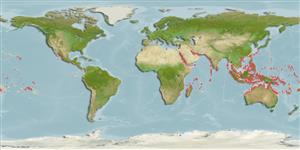Common names from other countries
Environment: milieu / climate zone / depth range / distribution range
Ecologia
marinhas associadas(os) a recifes; intervalo de profundidade 1 - 15 m (Ref. 90102). Tropical; 30°N - 24°S
Indo-West Pacific: Maldives (Ref. 30829) and Mauritius to Indonesia, Singapore, the Philippines, Papua New Guinea and the Solomon Islands. Recently reported from New Caledonia (Ref. 11889).
Tamanho / Peso / Idade
Maturity: Lm ? range ? - ? cm
Max length : 15.0 cm TL macho/indeterminado; (Ref. 48635)
Descrição breve
Morfologia | Morfometria
Espinhos dorsais (total): 3; Raios dorsais moles (total): 11-12; Espinhos anais 0; Raios anais moles: 6 - 7. Characterized by numerous prominent wart-like protuberances on its skin and a large esca that mimics a tiny fish. Bony part of the illicium with numerous crossbands and approximately twice as long as the 2nd dorsal spine. Coloration is highly variable, ranging from cream to yellow, brown, or black with scattered dark circular spots and saddles or blotches ranging from white to pink, rust-red, or red. Heavily spotted individuals resemble A. pictus. Usually has red or orange margins on all fins and the first band across the body diverts to the posterior edge of the eye which distinguishes it from A. pictus (Ref. 48635).
Inhabit sheltered rocky reefs (Ref. 559). Adults are usually with sponges (Ref. 48635). Juveniles openly on reefs looking like nudibranchs (Ref. 48635). Feeds on fishes (Ref. 89972). Oviparous. Eggs are bound in ribbon-like sheath or mass of gelatinous mucus called 'egg raft' or 'veil' (Ref. 6773). Solitary, frequently among algae, sponges and soft corals (Ref 90102).
Life cycle and mating behavior
Maturidade | Reprodução | Desova | Ovos | Fecundidade | Larvas
Oviparous. Eggs are bound in ribbon-like sheath or mass of gelatinous mucus called 'egg raft' or 'veil' (Ref. 6773).
Pietsch, T.W. and D.B. Grobecker, 1987. Frogfishes of the world. Systematics, zoogeography, and behavioral ecology. Stanford University Press, Stanford, California. 420 p. (Ref. 6773)
Categoria na Lista Vermelha da IUCN (Ref. 130435)
CITES (Ref. 128078)
Not Evaluated
Ameaça para o homem
Harmless
Utilização humana
Pescarias: sem interesse; Aquário: Espécies comerciais
Mais informação
Idade/TamanhoCrescimentoComprimento-pesoComprimento-comprimentoFrequência de comprimentoMorfometriaMorfologiaLarvasDinâmica larvarRecrutamentoAbundância
ReferênciasAquaculturaPerfil para aquaculturaEstirpesGenéticaElectrophoresesHereditariedadeDoençasProcessamentoMass conversion
ColaboradoresFotografiasStamps, Coins Misc.SonsCiguateraVelocidadeTipo de nataçãoÁrea branquialOutras referênciasCérebrosVisão
Ferramentas
Relatórios especiais
Descarregue XML
Fontes da internet
Estimates based on models
Preferred temperature (Ref.
115969): 25.2 - 29.3, mean 28.5 (based on 3049 cells).
Phylogenetic diversity index (Ref.
82804): PD
50 = 0.5005 [Uniqueness, from 0.5 = low to 2.0 = high].
Bayesian length-weight: a=0.01995 (0.00906 - 0.04395), b=3.01 (2.83 - 3.19), in cm Total Length, based on all LWR estimates for this body shape (Ref.
93245).
Nível Trófico (Ref.
69278): 4.2 ±0.73 se; based on food items.
Resiliência (Ref.
120179): Elevada, tempo mínimo de duplicação da população menor que 15 meses (Fec assumed to be > 10,000).
Fishing Vulnerability (Ref.
59153): Low vulnerability (10 of 100).
